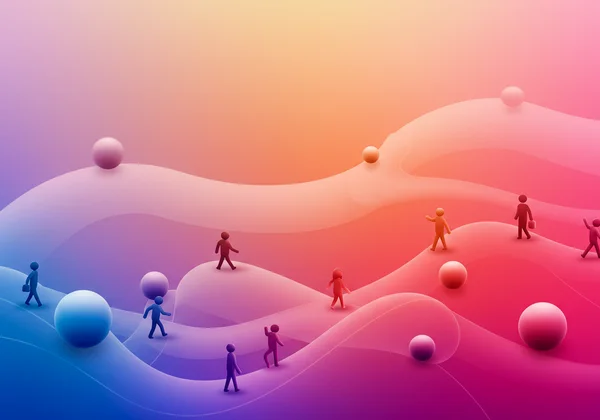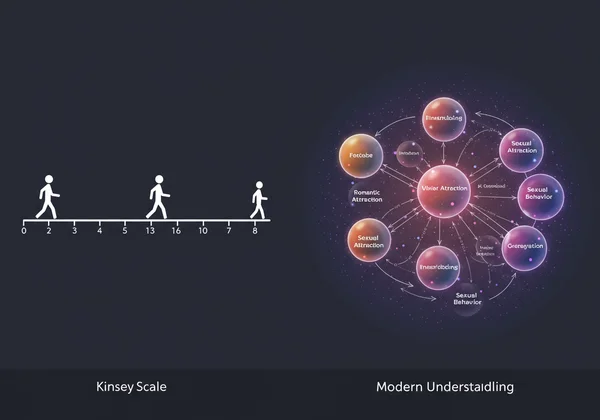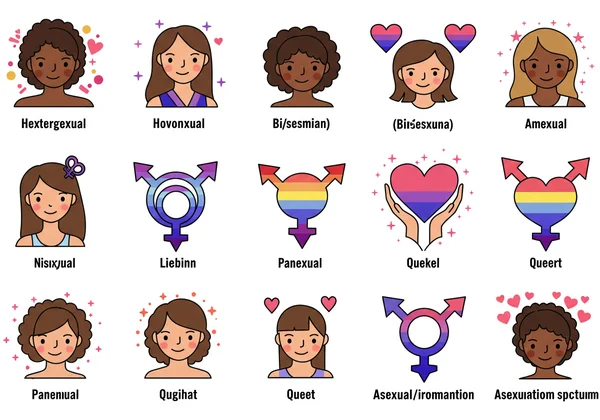性取向测试与光谱:探索多元化的吸引力
您是否在为自己的吸引对象而感到困惑?在这个常常将吸引力描绘成简单二元对立的世界里,理解人类性征的完整、丰富光谱,可以是一段解放性的自我发现之旅。许多人会不禁自问:“ 我如何知道我的性取向? ”,而寻找答案的过程可能会让人感到不知所措。本指南旨在揭开性取向光谱的神秘面纱,提供一个包容且具有认可度的视角来理解我们的吸引力体验。一个保密的 性取向测试 可以是您个人探索过程中一个有力的第一步,为您提供一个安全的空间来反思您的感受。如果您已准备好开始,可以 点击此处开始您的旅程。
什么是性取向光谱?
性取向光谱是一种理解性取向的方式,它超越了僵化的分类。与其将性取向视为一套泾渭分明的盒子——例如“同性恋”或“异性恋”——不如将其视为一个连续体。这种模型承认,一个人的浪漫和性感受可以存在于这条线的任何位置,甚至同时存在于多个位置。它是一个尊重细微差别、复杂性和个体经验独特性的框架。这种方法有助于肯定那些不完全符合传统标签的感受,许多人觉得这给人带来极大的自由感。
超越二元思维:吸引力的连续体
长久以来,关于性取向的讨论都为 二元思维 所主导,当时只有异性恋和同性恋被广泛认可。这种狭隘的观点为人类吸引力的巨大多样性留下了空间。 吸引力连续体 的概念对此提出了挑战,并说明了我们被谁吸引并非一个非此即彼的问题。
想象一条线,一端是纯粹的异性恋,另一端是纯粹的同性恋。许多人则处于这两点之间,会对一个以上的性别产生吸引。还有些人可能发现他们的感受根本不在这条线上。光谱模型更像一张多维地图,考虑了不同类型和程度的吸引力,为人类的联结描绘了更准确、更具包容性的图景。

历史背景:金赛量表与现代理解
最早且最著名的描绘这一连续体的尝试之一是 金赛量表。该量表由生物学家阿尔弗雷德·金赛(Alfred Kinsey)于 20 世纪 40 年代开发,将个体评定为 0(纯粹异性恋)至 6(纯粹同性恋),并设有“X”类别,用于描述那些没有社会性接触或反应的人。尽管在当时具有革命性,金赛量表也有其局限性。它主要关注行为,并未充分考虑浪漫吸引、身份认同或无性恋相关光谱。
如今,我们的理解已经发展。我们认识到性取向是多方面的,包含几个不同的组成部分:
- 性吸引力: 您在身体上被谁吸引。
- 浪漫吸引力: 您渴望与之建立浪漫关系的对象。
- 性身份: 您选择用来描述自己性取向的标签(例如:双性恋、泛性恋、酷儿)。
- 性行为: 您与之发生性关系的对象。
这些要素并不总是完全一致,这是完全正常的。一个现代的 在线性取向测试 旨在考虑这些细微差别,为反思提供一个更全面的起点。

探索不同类型的性取向
理解光谱上的 性取向类型 可以为您描述自己的感受提供语言,帮助您感到被看见和理解。请记住,这些标签是为了帮助您了解自己,而不是将您束缚起来。无论您认同某个特定标签、多个标签,还是没有任何标签,您的经历都是有效的。目标是自我认知,而非自我局限。探索这些身份可以是您旅程的关键部分,而 性取向探索测试 只是众多可以帮助您找到正确方向的工具之一。
理解常见的性取向
尽管光谱浩瀚,但有几个 常见的性取向 可以作为有用的参照点。这些定义是简化的,并且对于每个人来说,其细微之处可能更深。
- 异性恋: 主要被不同性别的人吸引。
- 同性恋: 主要被同一性别的人吸引(通常男性称为“gay”,女性称为“lesbian”)。
- 双性恋: 被一个以上的性别吸引。历史上,这曾指对男性和女性的吸引,但如今其含义已更为广泛。
- 泛性恋: 不论性别认同如何,都可能被他人吸引。关注点在于个体本身,而非其性别。
- 酷儿(Queer): 一个总括性术语,一些人用来描述非异性恋的身份。这是一个拥抱模糊性和流动性的标签。
探索无性恋与无浪漫吸引光谱
现代关于性取向的讨论中,一个关键部分是 无性恋光谱 与 无浪漫吸引光谱。无性恋(或称“ace”)通常指很少或完全没有性吸引力。无浪漫吸引(“aro”)则指很少或完全没有浪漫吸引力。这是两个不同的光谱;一个人可以是无性恋但并非无浪漫吸引,反之亦然。
在这些光谱中,还有许多其他身份,例如:
- 半性恋(Demisexuality): 仅在形成深厚情感联系后才体验性吸引。
- 灰性恋(Greysexuality): 很少体验性吸引,或吸引力强度很低。
认识到这些性取向对于全面理解人类吸引力光谱至关重要。它肯定了那些不按照社会期望体验性或浪漫吸引力的人们的经历。

性身份连续体:您的个人旅程
您的性取向是您是谁的核心部分,它完全属于您。 性身份连续体 强调您的旅程是个人的、独特的。找出自己性取向没有正确或错误的时间表,今天感觉合适的方式,明天也可能发生演变。这并非困惑的迹象,而是人类体验的自然组成部分。拥抱这个过程可以带来深刻的自我接纳和幸福感。一个 免费性取向测试 可以充当一面镜子,毫不评判地映照出您当下的感受。
吸引力的流动性
对于那些探索自己身份的人来说,最令人宽慰的概念之一是 吸引力的流动性。您的吸引力和您的身份认同可能随着生命周期而改变。一个在青少年时期认同为异性恋的人,可能在二十多岁时意识到自己是双性恋;或者一个认同为同性恋的人,之后可能会发现自己是半性恋。这并不会否定过去的经历或感受。相反,它突显了我们在生活中不断成长和加深自我理解的能力。这种流动性是人类体验中正常且美好的一个方面。
自我发现为何重要:拥抱真实的自我
归根结底,整个旅程都是关于 拥抱真实的自我。理解您在性取向光谱中的位置,可以减轻焦虑,建立自信,并改善您的人际关系。当您拥有理解内心世界的语言和框架时,您就可以更诚实、更开放地生活。这个过程不仅仅是找到一个标签;更是允许自己毫无歉意地做真实的自己。这场自我发现之旅将赋能您构建一个真实且充实的生活。要踏上这段旅程的下一步,您可以 探索您的吸引力,通过我们的保密问卷。

拥抱您在人类吸引力光谱中的独特位置
在探索性取向的世界里,可能会感到复杂,但它同时也是一段非常有价值的旅程。人类吸引力光谱是一个由多元化经历构成的美丽织锦,每个人都能找到自己的位置。您的感受是真实的,您的旅程属于您自己,您并不孤单。通过超越二元思维,拥抱流动性和自我发现的概念,您可以找到清晰和内心的平静。
如果您正在寻找一个支持性的工具来帮助您反思,请考虑参加我们基于科学见解的 性取向测试。这是一个保密的、免费的、包容性的资源,旨在帮助您更轻松地探索,让生活更丰富。 立即发现您的结果。
关于性取向光谱的常见问题
性取向有哪些不同的类型?
性取向光谱上有许多身份认同。一些常见的包括异性恋(被不同性别的人吸引)、同性恋(被同一性别的人吸引)、双性恋(被一个以上的性别吸引)、泛性恋(不考虑性别而被吸引)以及无性恋(很少或完全没有性吸引力)。关键在于找到最能描述您个人经历的语言(如果有的话)。
我如何知道我的性取向?
了解您的性取向是一个自我反思的过程。留意您在浪漫、情感和身体上被谁吸引。思考您的白日梦和感受。这没有截止日期,感到不确定也是完全可以的。像 性取向问卷 这样的工具可以提供一些见解,但最终,您是自己经验的专家。
测试能告诉我我的性取向吗?
测试无法明确地告知您您的性取向。相反,一个设计良好的 性取向测试,例如我们的测试,应被视为自我反思的工具。它会提出引人思考的问题,帮助您整理感受,并探索您可能未曾注意到的模式。结果是您自我审视的起点,而不是最终诊断。
“疑问中”是什么意思?
“疑问中”(Questioning)是用来描述一个正在探索或不确定自己性取向或性别认同的人的术语。对于许多人来说,这是旅程中完全有效且正常的组成部分。这意味着您给自己留出了时间和空间来更好地了解自己,而不必急于立即选择标签。
这个性取向测试准确吗?
我们的测试是基于心理学研究的见解而设计的,旨在成为一个可靠且周到的自我探索工具。然而,它的“准确性”在于其帮助您诚实反思自身感受的能力。我们优先考虑您的隐私,并提供一个安全、无评判的空间。它是一个信息指南,而非临床评估,旨在支持您的探索之旅。